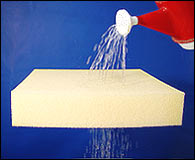One of the most green choices a consumer can make starts with their food choices. We're not just talking about the color of the food, although green, leafy food has a number of health benefits. Instead, you have a chance to promote a green planet with every single choice you make about what, where, how, and why you're eating.
 |
| Visit their free green-living tool, One Small Act and join the “Eco Eats” challenge. |
The environmental cost of year-round availability of food is tremendous. From the cost of shipping food across the nation from warmer climates to cooler ones to the chemical fertilizer put into the soil to force food to grow out of its natural growing season, to the additional water required to compensate for dry seasons when the soil would traditionally rest, we ask a lot out of our earth for the luxury of year-round unlimited choices. Additionally, the quality of food that is not-seasonal or shipped from faraway diminishes. In order to ship tomatoes for example, they are picked before they are ripened, and then gassed with ethylene so they achieve a "reddish-orange" tomato-esque color. Barry Estabrook, author of 2011's Tomatoland: How Modern Industrial Agriculture Destroyed Our Most Alluring Fruit, explains.
Fields are sprayed with more than one hundred different herbicides and pesticides. Tomatoes are picked hard and green and artificially gassed until their skins acquire a marketable hue. Modern plant breeding has tripled yields, but has also produced fruits with dramatically reduced amounts of calcium, vitamin A, and vitamin C, and tomatoes that have fourteen times more sodium than the tomatoes our parents enjoyed. The relentless drive for low costs has fostered a thriving modern-day slave trade in the United States.That is just for tomatoes. Extrapolate that same treatment to every choice we are given at the grocery store and you can easily understand how our demand for year-round selection isn't necessarily the healthiest or sustainable decision. Would you join me in the pledge to eat more local and seasonal food?
If you are interested in ‘eco-eating’? NBC’s Green is Universal is hosting an “Eco Eats” sweepstakes from September 29 – October 17. Everyone who signs-up and tackles at least one action by October 17th will be entered to win one of five 6-month subscriptions to NatureBox. No Purchase Necessary. Must be US resident and 18+. Read official rules here.
disclosure: In exchange for participating in the challenge and writing a post with my opinion, I am eligible for a gift package from Green is Universal.





